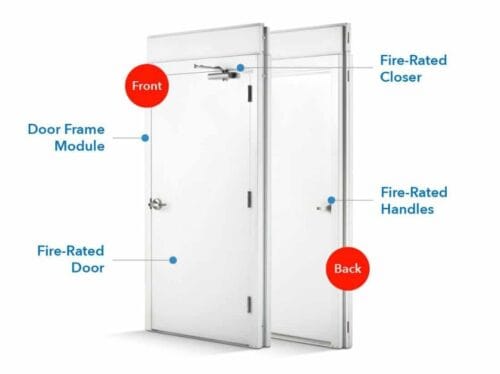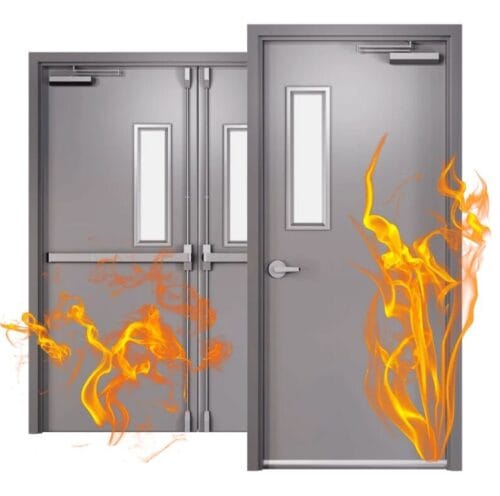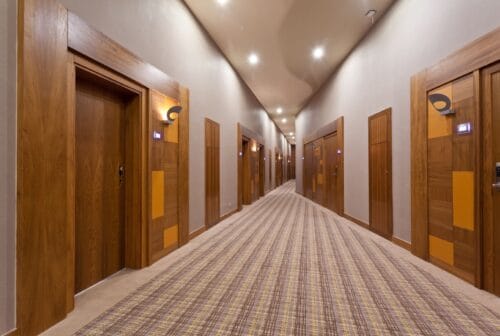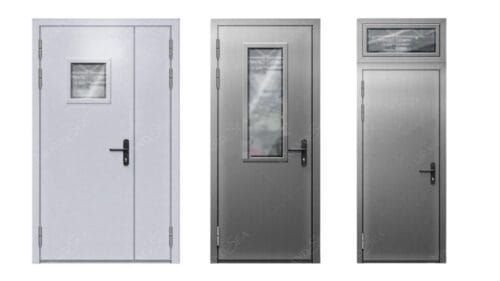Fire can be devastating, and when emergencies occur, every second counts. This is where fire-rated doors become essential. They are engineered to prevent the spread of smoke and fire from one area of a building to another, making them critical components of any effective fire safety strategy.
So, why are these doors so important, you might ask? Well, for a few really good reasons:
Fire-rated doors give occupants valuable extra time to escape safely during a fire. By containing the fire, they significantly reduce building damage and help keep escape routes clear of smoke and flames, making evacuation easier. In many non-domestic buildings, installing fire-rated doors is also a legal requirement.
This guide will cover everything you need to know about fire-rated doors, including their construction, functionality, typical applications, and key considerations for selection.

What Is a Fire-Rated Door?
A fire-rated door is not merely a single door slab but a complete, engineered system known as a fire-rated door assembly. Think of it as an integrated system where each component plays a crucial role.
The Fire-Rated Door Assembly: More Than Just a Door
A fire-rated door assembly consists of several key components that work together as a system:
- The Door Slab: The main component, made from fire-resistant materials such as aluminum, fire-rated glass, hollow metals (such as steel), or occasionally wood.
- The Frame: This is what the door hangs in. It’s often made of hollow metal as well, but can also be aluminium or wood depending on the setup.
- The Hardware: All components facilitating the door’s operation must be fire-rated, including:
- Hinges: Usually steel with ball bearings
Latching Mechanisms: Positive latching to keep the door securely closed.
Closing Devices: Ensure the door is self-closing after use.
- Seals and Gaskets: Essential for stopping smoke and hot gases; intumescent strips expand when heated, and smoke seals and gaskets provide additional protection.
- Vision Lites: Any windows must use fire-rated glass.

How Fire-Rated Doors Work
So, how do these doors work, exactly? Their effectiveness lies in their specialized construction and the advanced materials used. They are built with materials engineered to resist warping and structural failure under intense heat. The intumescent seals mentioned earlier are a key component; they expand when exposed to heat, filling the space between the door and the frame to provide a very tight barrier. It is crucial that fire-rated doors are engineered to remain closed during a fire to contain flames and smoke.
Decoding Fire Ratings and Standards
Next, consider the numbers and letters associated with fire-rated doors—the fire ratings. These tell you how long a door can withstand fire in a controlled testing environment.
Understanding Fire Resistance Ratings (Time)
Typical ratings include 20, 30, 45, 60, 90, or 180 minutes. For example, an FD30 door is designed to provide 30 minutes of fire protection. Note that these ratings are based on controlled tests, and actual performance may vary in real-life situations.
Temperature Rise Ratings
Beyond containing flames, some applications require limiting the amount of heat that transfers through the door. These doors, known as ‘temperature rise doors,’ have an additional rating (e.g., 250°F, 450°F, or 650°F). This rating indicates the maximum allowable temperature increase on the non-fire side of the door during the first 30 minutes of a fire test. The 250°F grade was the strictest, offering the least transfer of heat. This is of particular importance for the preservation of escape paths.

Smoke and Draft Control
Since smoke is lethal, being just as dangerous as flames, some fire-rated doors are also tested for their ability to impede smoke from spreading. You may notice an “S” classification (such as FD30S) which indicates the door has been tested for smoke resistance.
Key Testing Standards
Testing fire-rated doors is essential to verify their proper function. Key test standards include:
- UL 10B: Tests fire endurance under neutral or negative pressure.
- UL 10C: Tests fire endurance under positive pressure, which is now the standard for swinging fire doors.
- NFPA 252: Another key standard for fire testing of door assemblies.
- The tests often include a fire endurance test, where the door is blasted with extreme heat (up to around 1925°F for a 180-minute rating!). If it holds up without through openings and limits flames, it gets its rating.
- Following the fire endurance test, a hose stream test is often conducted. A high-pressure fire hose is sprayed on the hot door assembly to test its structural integrity against thermal shock.
Relevant Building Codes and Standards Organisations
Of course, all of this is underpinned by building codes and the hard work of standards organisations. In the UK, you’ll be looking at regulations that often align with standards developed by organisations like BSI. In the US, key players include:
- International Building Code (IBC).
- International Fire Code (IFC).
- National Fire Protection Association (NFPA) especially NFPA number 80 concerning fire doors and other opening protectives along with 101 which is the life safety code.
Where are Fire-Rated Doors Required?
So, where exactly do you need to have these special doors? The answer depends on the type of building and what areas you’re talking about.
Commercial Buildings: Legal and Safety Imperatives
The installation of fire rated windows and doors is a legal requirement for fire safety in almost all high traffic places or areas such as offices, shopping malls and public buildings. You will see them installed in stairwells, corridors and designated escape routes. Different areas usually have specific rules that specify fire-rated thresholds or standards.

Residential Buildings: Enhancing Home Safety
While regulations for residential buildings are often less stringent than for commercial properties, fire-rated doors significantly enhance home safety. Even when not required by code, the additional protection they provide makes them a worthwhile investment. However, it is always prudent to consult local building codes for specific residential requirements.
Specific Applications and Required Ratings
Just to give you an idea, here are some typical applications and the fire ratings often required:
- Firewalls or building division walls: Often require the highest rating, like 180 minutes.
- Openings to elevator shafts or stairwells: Typically around 90 minutes.
- Doors dividing different occupancies within a building: Might need a 60-minute rating.
- Doors in corridors or room partitions: Often require 20 to 45 minutes, sometimes with smoke control.
Selecting the Right Fire-Rated Door: A Step-by-Step Guide
Choosing the correct fire-rated door is crucial for ensuring safety and meeting regulations. Here’s a rundown of what you need to think about:
- Consult Local Codes and AHJs First: This is always the starting point. Find out exactly what’s required in your specific situation.
- Determine the Required Fire Rating: This will depend on where the door is being installed and the fire rating of the surrounding walls.
- Material Considerations: Consider the door material. Steel and fiberglass are the most common choices for fire-rated doors. Evaluate fire rating, appearance, durability, and cost.
- Hardware Selection: Remember, all hardware must be fire-rated and compatible with the door and frame assembly.
- Glazing Choices: If you need a window, make sure you choose the right type of fire-rated glass. Understand the difference between fire-protective (stops flames and smoke) and fire-resistive (also limits heat transfer) glazing. Be aware of size limitations, especially for higher fire ratings.
- Aesthetics and Design Integration: Fire safety doesn’t mean you have to compromise on looks. Fire-rated doors come in various styles and finishes these days.
- Considering Temperature Rise Requirements: If the door is in an escape route, a temperature rise rating might be necessary to protect people during evacuation.
Grandsea is a leading door manufacturer with certified testing of the entire door assembly (door, frame and hardware) and we can provide the certifications needed to get you through the building audit process quickly and get a high-quality fire-rated door.

Installation, Maintenance, and Inspection: Ensuring Ongoing Protection
Selecting the correct door is the first step; proper installation is equally critical. An incorrectly installed fire-rated door assembly will not perform as designed in a fire. Be sure to adhere to the standards and the manufacturer’s recommendations.
And it doesn’t stop there! Maintaining Your Fire-Rated Doors. Regular examination and care are essential to ensure fire-rated doors remain effective. This responsibility falls to building owners and facility managers.
- No open holes or breaks in the door or frame.
- Glazing and vision light frames are intact and secure.
- The door, frame, hinges, and hardware are secure, aligned, and undamaged.
- No parts are missing or broken.
- Door clearances at the frame edges are within the specified limits.
- The self-closing device is working properly.
- Latching hardware operates and secures the door.
- No unauthorised extra hardware has been added that could interfere with operation.
- No unauthorised modifications have been made to the door assembly.
- Gasketing and edge seals are present and in good condition.
- The fire rating label is still attached and easy to see.
Regular inspections are recommended, not just during formal checks. Maintaining records of all inspections and maintenance is also advisable.
Avoid common installation and specification mistakes, such as using non-compliant hardware, improperly sealing gaps, making unauthorized cutouts, or propping fire doors open. Any of these errors can compromise the integrity of the door assembly and void its safety rating.
Conclusion
Fire doors are a critical element in preserving lives and property. Remember to select the appropriate fire door, ensure proper installation, and maintain it regularly.
The importance of fire-rated doors in protecting lives and property cannot be overstated. Always consult with certified professionals, adhere strictly to local building codes, and source your assemblies from a reputable manufacturer like Grandsea, SAFTI FIRST, or JELD-WEN. A high-quality, properly maintained fire-rated door is a critical investment in safety that performs when it matters most.


